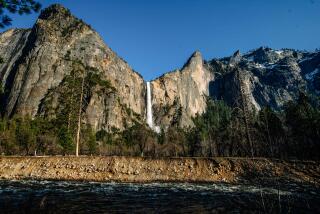Yosemite-Area Killings Remind Women That Crime Isn’t Confined to Big Cities
- Share via
When you mention the killings of four women this year in and around Yosemite National Park to women who love the wilderness, there is deep silence at first, and then a pall. “I’ve hiked in that area alone, myself,” says Donna Hunter, owner of Mariah Wilderness Expeditions, a Bay Area tour company dedicated to taking women into the outdoors. “But I won’t do it anymore.”
There is some relief, too, since Cary Stayner, a 37-year-old handyman at a motel near El Portal, on Yosemite’s western threshold, admitted two weeks ago to the murders of Carole and Juliana Sund, Silvina Pelosso and Joie Ruth Armstrong. Stayner, a ruggedly handsome outdoors enthusiast, is said to have told interrogators that he’d been thinking of killing women since he was a boy. He is likely to be questioned about the unsolved murders of more women in nearby counties over the last five years.
It all adds up to something out of a Thomas Harris novel (“Hannibal”), or the nightmare-inspiring stories Girl Scouts tell over campfires about demented killers loose in the woods. For those of us who love the outdoors and think of it as a haven, the murders are not only terrifying but sobering, leading us to wonder whether we can ever be safe again in natural wonderlands like Yosemite National Park.
“The same things that plague big cities can be found in parks, including heinous crimes,” says Chris Fister, a female ranger who has worked alone in back-country areas of Glacier Bay and Denali national parks in Alaska and is currently stationed at Sequoia and Kings Canyon national parks in central California. “The recent killings in Yosemite reinforce the fact that I can’t be complacent.”
Deaths are far from uncommon in America’s 378 national parks, but most are caused by ill health and accidents resulting from bad weather, lack of preparation for wilderness conditions or inexperience. While search-and-rescue missions are on the rise, homicides in the nation’s parks system have fallen 64% since 1990, with just 10 reported in 1998. The last murder in Yosemite occurred 12 years ago, when a man pushed his bride over a cliff.
Kendell Thompson, a Yosemite ranger, said the park has gotten few anxious calls about the murders. “People [are] more curious than concerned,” he noted. “Most recognize that the recent killings were isolated incidents and that the suspect is in custody.” Visitation is actually up 3% since the Sund/Pelosso party disappeared in February, with Yosemite remaining one of the most popular national parks in the country, according to statistics.
Among experienced outdoorswomen, it is commonly believed that bad things don’t happen in the wilderness because human predators are unlikely to hike many miles into the back country to perform violent acts. They point to the report that Stayner attacked the Sunds and Pelosso in their room at a hotel outside the park. (Though the murder of Joie Armstrong, a Yosemite Institute natu
ralist, occurred at her home in the cottage enclave of Foresta, within park boundaries.) “Going into the woods isn’t the problem,” says Carole Latimer, founder of Call of the Wild, a Berkeley-based wilderness tour company for women. “It’s getting there, that’s the problem.” In the wake of the murders, none of her clients signed up for Yosemite expeditions has canceled. But she reports that one woman called looking for a driving companion, since she didn’t want to make the trip to the meeting point alone.
To many, the fact that Stayner managed to overpower three women in the February killings seems imponderable. But Armstrong’s murder on July 21 occurred when she was by herself, raising fear among women about being in the wilderness alone. The national park discourages solitary hiking and backpacking, for men or women, largely because it lowers the chances of rescue in case of accident. But Latimer and others hate to contemplate a world in which it isn’t safe for an experienced outdoorswoman to go into the wilderness alone. “I just wouldn’t give it up,” Latimer said. “The greatest experience of my life was when I was backpacking by myself.”
These days, though, she exercises as much caution in the woods as she would in the big city. Here are a few tips for women to keep in mind when planning a wilderness expedition:
* Let someone you trust know your itinerary and when you expect to return home. But don’t chat casually about your plans with strangers.
* Educate yourself about the area where you plan to hike. Check in at a ranger station or visitors’ center for updates.
* If you plan to stay in a motel, make reservations before you leave on the trip so you’re not forced to overnight someplace that doesn’t feel safe.
* Take a self-defense class to prepare for dangerous encounters and help you learn to identify potential miscreants.
* If you’re alone on a trail and meet up with someone you distrust, say that your boyfriend or husband is just around the bend--a lie even your mother wouldn’t fault.
* And, as Carole Latimer says, “Don’t be so nice and polite. You don’t want to get a nut angry, but there’s no reason why women have to be compliant.”
Keeping your antennae up in the wilderness is the long and the short of it. I’ve backpacked by myself often, though only in places where I feel deeply confident, like the English Lake District or the Brittany coast. And I do day hikes in national parks alone, but never without a lie handy, and constantly looking over my shoulder.
More to Read
Sign up for Essential California
The most important California stories and recommendations in your inbox every morning.
You may occasionally receive promotional content from the Los Angeles Times.










